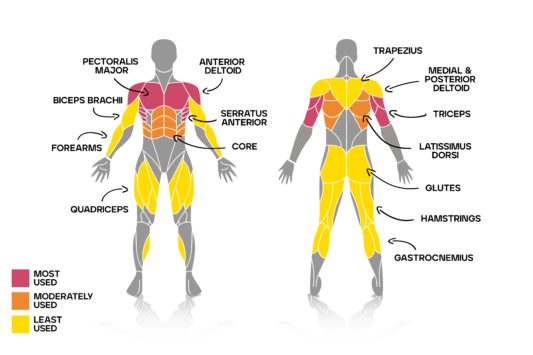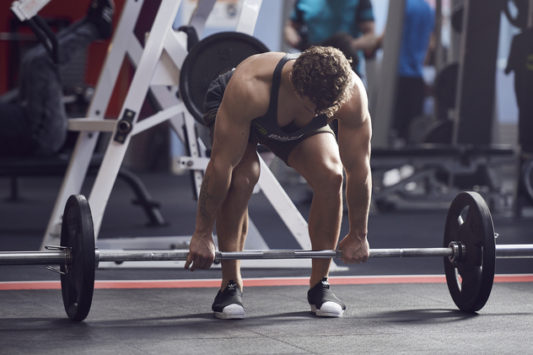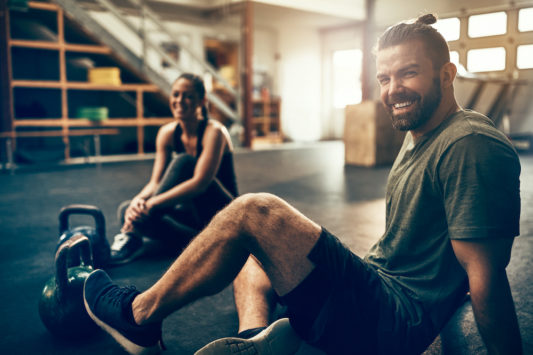As you’ll have probably noticed, there are a number of different variations to the bench press. The angles utilised most frequently include incline, decline and flat. As well as this, the bench press can be performed with either a barbell, or dumbbells.
This article will explain the benefits of each variation, and help you to gain an understanding as to which variations you’ll benefit from incorporating into your training routine in order to improve your chest!
Anatomy of the Chest
The chest is made up of two main muscles, the pectoralis minor and pectoralis major.
Both of these muscles are required in order for you to perform a bench-pressing movement, however the angle at which you perform the exercise at will determine exactly how much involvement is required by each muscle.
‘Upper Chest’
Your pec-minor is most made use of when pressing at an inclined angle. Most people believe a 45° angle is required for the best activation of the pec-minor, however an angle this inclined will put most of the emphasis on the anterior deltoid. Instead, you should adjust the height of your bench to 30° when performing an incline bench press.
Sometimes you may not be able to adjust the angle of your bench press, particularly if it’s a barbell bench press. In this case, first practice the movement and determine whether you feel your shoulders taking over the movement too much. Ensure you keep your scapular retracted throughout the press and you have a strong form (see below for form explanation).
The dumbbell variation of this movement is a fantastic alternative when it comes to targeting the pec-minor, and you should definitely consider this over the barbell variation if you’re looking to improve your upper chest.
‘Middle-Lower Chest’
Your mid-to-lower chest is made up mostly by the pec-major. Both the flat variation and the decline variation of this movement work well to target the bulk of your chest effectively.
Using a flat bench-press will enable you to improve your actual bench-press strength; so, if you have ambitions of powerlifting and want to kill two birds with one stone and increase the size as well as strength of your chest, you’ll definitely want to incorporate the flat barbell bench-press into your routine. The flat variations (both dumbbell and barbell) do a great job at activating your whole chest, however the barbell variation will allow you to lift more weight in a controlled manner.
Finally, the decline bench-press. This movement typically requires more involvement from the triceps, and due to the movements’ similarity to a chest/triceps dip, most people find they can lift more weight on the decline bench-press compared to flat. As well as this, the decline bench-press targets the pec-major incredibly due to the direction in which the muscle fibres run from the origin at the sternum to join the humerus at the insertion. A barbell is most suitable for this movement; although you’ll likely be able to decline dumbbell press more than flat/incline, it’s likely your triceps will take more of the load during this exercise, and so if you want to make sure you’re targeting your chest optimally, you should opt for the barbell variation and ensure a full range of motion on each repetition. A decline position of 30° is most suitable to ensure you’re able to let the bar travel in a straight line from your lower chest to lockout (see form explanation below).
Form Explanations
Incline Barbell Bench-Press
- Adjust the bench to an inclined height of 30°, or as near to as possible; ensure the movement is comfortable and the shoulders aren’t taking over
- Keep feet planted and shoulders retracted throughout the whole movement
- Create a small arch in the lower back
- Grip the bar comfortably so that your elbows are just beneath your hands, creating a 45° angle when performing the eccentric part of the movement
- Lower the bar until it touches your chest
- Breathe in during the eccentric contraction and breathe out when pressing (concentric)
Incline Dumbbell Bench-Press
- Adjust the bench to an inclined height of 30°
- Keep your feet planted but bring them slightly in order to keep your balance on the bench
- Retract shoulder blades throughout the whole movement
- Create a small arch in the lower back
- Create a 45° angle when performing the eccentric part of the movement and allow the dumbbells to travel to towards the side of your chest slowly
- Press up before hyper-extension of the anterior deltoid (as your elbows create a right angle)
- Breathe in during the eccentric contraction and breathe out when pressing (concentric)
Flat Barbell Bench-Press
- Ensure the bench is flat, and the bar is loaded to the appropriate rack so that it’s comfortable for you to lift it off
- Keep feet planted and shoulders retracted throughout the whole movement. You can try bringing your feet back and using the balls of your toes to balance and increase the arch in your lower back if you’re aiming to improve your powerlifting too
- Create a small arch in the lower back by retracting the shoulder blades and keeping your glutes on the bench throughout
- Grip the bar comfortably so that your elbows are just beneath your hands, creating a 45° angle when performing the eccentric part of the movement
- Lower the bar until it touches your raised chest
- Breathe in during the eccentric contraction and breathe out when pressing (concentric)
Flat Dumbbell Bench-Press
- Ensure your bench is flat
- Keep feet planted and shoulders retracted throughout the whole movement
- Create a small arch in the lower back
- Create a 45° angle when performing the eccentric part of the movement by allowing the dumbbells to lower towards each side of your chest
- Lower the dumbbells until your elbow create right-angles and then press
- Breathe in during the eccentric contraction and breathe out when pressing (concentric)
Decline Barbell Bench-Press
- Adjust the bench to a declined height of 30°, or as near to as possible
- Keep shoulders retracted and use your legs as hooks around the footholds of the decline bench-press
- Tense your glutes by pulling your legs backwards slightly in order to create a strong posture with your shoulders back and creating a small arch in the lower back to raise your chest
- Grip the bar comfortably so that your elbows are just beneath your hands, allowing the bar to lower and touch the bottom of your raised chest before pressing back up
- Keep your elbows tucked in throughout
- Breathe in during the eccentric contraction and breathe out when pressing (concentric)
Decline Dumbbell Bench-Press
- Adjust the bench to a height of 30°, or as near to as possible
- This exercise must be performed on a bench which allows you to secure your legs
- You’ll need a friend to pass your dumbbells up to you once you’re seated and secured
- Create a small arch in the lower back by retracting the shoulder blades and keeping your glutes contracted
- Lower the dumbbells slowly until they reach each side of your chest, and press while keeping your elbows tucked in so that they’re kept under control
- Breathe in during the eccentric contraction and breathe out when pressing (concentric)
The Optimal Recipe
Ideally, a combination of the incline dumbbell bench press, and decline or flat barbell bench press would work best, depending on your goals. It’s vital that you ensure your benches are adjusted to the correct heights, in order to make sure you’re targeting the correct muscles effectively.
For the best all-round results you should accompany these pressing movements with some accessory exercises such as the cable fly and the chest press/incline chest press.
Take Home Message
Make sure you use a variety of angles in your chest workout rather than sticking to just one movement. You should also utilise both dumbbells and barbells for optimal results. Adjust the heights of your benches to suit your build and ensure you’re performing each exercise with accurate and efficient form.
Related articles
Looking to learn more? We believe that every person, with support, has the right to transform their lives through fitness. That’s why we’ve put together hundreds of articles with expert advice, all to help you on your fitness journey. Here’s some more articles around deadlifts and other leg-related movements.
Romanian deadlift vs deadlift How to increase your deadlift
Deadlifting for beginners How to improve pulling power
Deadlifting with expert powerlifter How to train hamstrings
Hip warm-up for squats How to build big quads
Gym exercises for footballers How to train your posterior chain
Deadlift muscles worked
Bench press muscles worked













